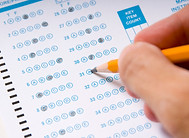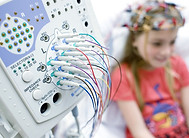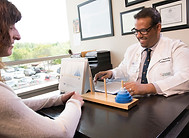What exactly is...
ATTENTION DIFFERENCE DISORDER?
Attention Deficit / Hyperactivity Disorder (ADHD)
While the clinical diagnosis is certainly not labeled attention "difference" disorder, we prefer that term, because having ADHD, like any other mental and physical diagnosis, comes with pros and cons, both. ADHD is a persistent pattern of inattention and/or hyperactivity-impulsivity that interferes with functioning or development. The latter part is of most importance. Just because someone is inattentive or impulsive, alone, doesn't warrant a diagnosis of ADHD.
We should also point out that ADHD is often misunderstood, and even more often... misdiagnosed. One reason for the mass over-diagnosis is that primary care practitioners do not have the time required (or the testing equipment) to do a thorough neuropsychological evaluation. Instead, they often must rely on only two points of data: (1) their observation, and (2) the parents' rating scales. Clinical research shows over and over that this is not an adequate way to diagnose ADHD.
ON THE OTHER HAND: Our doctors test six points of data, to get the best (and most accurate) results.
Here is what is included in OUR testing for ADHD:

1. CLINICAL INTAKE AND OBSERVATION is a large part of any neuropsychological evaluation. Because testing takes several hours (broken up into more than one days), we are afforded a lot of time to observe the patient. School observation is ideal, unfortunately, insurance rarely covers this. However, if requested, we can arrange to provide it, private pay.

2. RATING SCALES help us get a lot of data, from a lot of people, without spending hours upon hours of clinical interviewing. Rating scales are generally completed by the parents, other family members, teachers, and if the patient is old enough, they themselves. Please remember to thank your teachers for helping with rating scales, they are often underpaid and under-appreciated.

3. NEUROLOGICAL TESTING is fairly new to the ADHD evaluation world. Although neuro-feedback has been used in treatment, only in recent years has the FDA finally approved EEG testing to be used as a part of a comprehensive ADHD evaluation. EEG testing takes only minutes and is completed in our office. It is simple and painless, albeit a bit boring. It is generally not covered by most insurance, so it is billed separately.

4. NEUROPSYCHOLOGICAL TESTING tells us things that neurological testing can't - how is a patients memory? How about their processing speed? Is their visuospatial functioning intact? Executive functioning? We use several well-known tests, such as Wechsler, Delis-Kaplan, NEPSY, and more, but we never use a "standard" battery; we always tweak our battery to fit each unique patient.

5. CONTINUOUS PERFORMANCE TESTING is exactly what it sounds like: the patient is asked to perform a fairly mundane test for a long period of time. CPTs are helpful in making an ADHD determination, but shouldn't be used alone, to make diagnostic decisions. We test both visual performance, as well as auditory performance - since some kiddos' attention might be better engaged in one type over the other.

6. PSYCHOLOGICAL TESTING is often neglected in neuropsychological evaluations. At first, that makes sense... the evaluation is looking for neuro-based disorders. But all too often, emotional symptoms are present which may be accounted for by neurodevelopmental disorders - but may not be. We always test for emotional disorders, using at least two instruments, usually three. P.S., the image isn't of a real Rorschach inkblot; however, we do use the Rorschach on occasion.
Remember...
A good psychological battery uses scientifically validated measures, in the way they were intended to be used, and pulls data from several sources. So, for example, an EEG test alone should never be used to make a diagnosis (and as expected, the FDA requires that it be used only as one part of a comprehensive evaluation, that includes other tests). Similarly, Continuous Performance Tests are not great (they produce false-negatives) at diagnosing ADHD when considered alone. However, taken in consideration with observation, ratings, neuropsychological testing, and psychological testing, these six approaches work together beautifully to provide the comprehensive data needed to make an accurate diagnosis.
It's also important to remember that there are evolutionary arguments that help explain ADHD. And people with ADHD are often highly creative (and that creativity simply isn't put to use in current school systems). Children with ADHD should not be harshly pathologized. Many researchers argue that ADHD is simply a failure for certain children to adapt to our modern way of teaching/educating. This is why we refer to ADHD as attention "difference." Should you medicate yourself or your child? Maybe. Our job isn't to answer that question for you. Our job is to give you (and your psychiatrist of family physician) the information you need to make an informed decision, and illuminate all paths to treatment, including acceptance, behavior modification, training classes, medication, school accommodations, and more. Our final report will the chock-full of helpful recommendations!
It can be hard to imagine life as a child with ADHD. Please watch the video below. It makes clear how ADHD can lead to anxiety, self-esteem issues, and even depression.
This touching video, animated by Erik Rosenlund, is entitled "Bokstavsbarn" which translates to English as:
"Falling Letters"

Life with ADHD
From a recently diagnosed young man after watching this video:
"I was diagnosed a few days ago at age 16 and the diagnosis makes so much sense. I always just thought I sucked at being a person."
From a mother that watched this video for the first time in our office:
"It's him."
.png)
